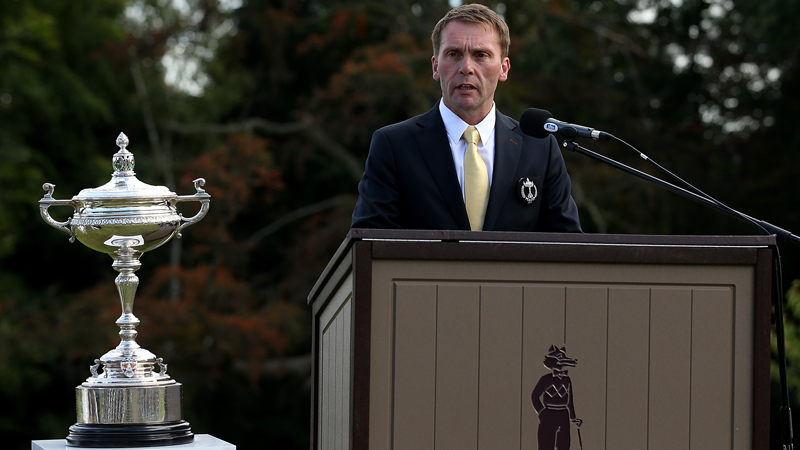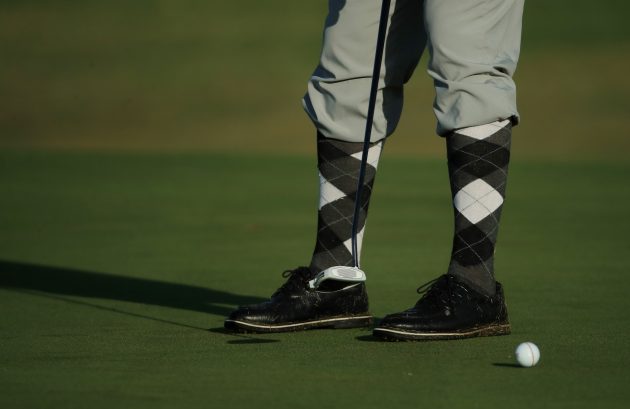"We Are Trying To Professionalise The Industry" - PGA CEO Robert Maxfield
We talk to Robert Maxfield, the top man at The PGA, about his hopes and ambitions for the organisation and the game of golf as a whole


We talk to Robert Maxfield, the top man at The PGA, about his hopes and ambitions for the organisation and the game of golf as a whole
"We Are Trying To Professionalise The Industry" - PGA CEO Robert Maxfield
It may, or may not, come as a surprise that the chief executive of the PGA (photo above) is neither a professional golfer nor a member of the organisation he leads.
He is very much a golfer, though, having played off plus figures for 30-odd years.
Robert Maxfield’s first ambition was to be a tour pro, but after nine months at Florida State University, he knew that living out of a suitcase away from family was not for him.
He embarked on a career as a trainee manager at The Belfry, becoming golf manager in 1991 and group golf manager for De Vere in 2004.
The Belfry is also home to The PGA, and in 2006, chief executive, Sandy Jones, enticed Maxfield into the fold to develop the PGA’s international commercial strategy.
Subscribe to the Golf Monthly newsletter to stay up to date with all the latest tour news, equipment news, reviews, head-to-heads and buyer’s guides from our team of experienced experts.
About a decade later, Maxfield was appointed deputy chief executive before taking over the reins when Jones retired in 2017.
His original tour pro ambitions weren’t realised, but Maxfield admits that becoming chief executive had been an ambition of his since joining the PGA.
Here, he talks about the evolution of the PGA’s membership structure via its 2020 Vision initiative, and some of the key issues facing golf and his organisation’s 8,000 members...
How much have the role and landscape changed for PGA pros in the last 20 years?
Massively. In my early days at The Belfry I very much saw the PGA professional as being the most qualified person in the industry because of the education they go through. At that time, their main role was either working at club level as a head professional or coaching. I always felt they had so much more to offer, which was why I ended up with so many. We employed 36 at The Belfry!
Over winter, I made them go and work in the hotel. They got a better all-round knowledge of hospitality and not just the golf business and a number are now managing facilities in Dubai, America and all over the world.
The big change for PGA professionals is that they’ve started to move into club management. We did a survey a couple of years ago, and 40 per cent of our members are now involved in some type of golf club management, which wouldn’t have been the case 20 years ago.
How long had your 2020 Vision initiative been under discussion?
If you go back to my time at The Belfry, I was an amateur golfer in one of the biggest golf operations manager’s jobs in Europe and there wasn’t a professional body I was able to join. I was an amateur so I couldn’t join the PGA, and there wasn’t another body that would have given me any professional support. Even prior to 2017 – probably going back to 2014 – I’d had this vision that the PGA, as an organisation that was completely changing with members moving into management, had an opportunity to broaden its membership to include anyone who worked in the golf industry.
And now that vision has become a reality…
Yes, over the past two years, with the support of the board, we’ve been evolving 2020 Vision to what it is today. We have the core membership of the PGA, which is fundamental to everything we do, but we’ve recognised that the PGA member is no longer just a PGA professional – they also coach and they manage. So we‘ve allowed PGA professionals to define themselves as a PGA professional, a PGA manager or a PGA coach.
But then, trying to embrace the rest of the industry, we’ve created the Business Management and Club Volunteer Groups, the intention being that anyone who works in golf or volunteers in golf can now become associated with the PGA – they can join either of those two groups.
It is still a fragmented industry, and if we can get people working together and all talking the same language, then we think that’s absolutely what the golf industry really needs.
Related: What does the PGA do?
How has Covid impacted your members and have any positives come out of it?
Going back to that first lockdown in March 2020, April and May are typically the busiest retail months for PGA pros, so that first lockdown was hard because of the uncertainty. Many PGA members have structured their businesses in such a way that they couldn’t access government support so that was a difficult period.
As an organisation, we didn’t furlough many staff. We tried to get on the front foot and called all our 8,000 members in early April to see what support and help they needed. We went into overdrive with communication. Government support is forthcoming but quite often it’s difficult to understand and interpret, so we interpreted it.
We then opened up, of course, and the volume of people that came at us in the summer was just breathtakingly positive. The challenge then was that you’d got PGA members who had been very quiet over that two-month period but were then working seven days a week, 15 hours a day to just cope with the amount of people.
Where has the industry succeeded and failed most over the last 20 years?
In so many ways we are trying to professionalise the industry, but I think one of the challenges is that many golf clubs are probably not quick enough to change. Going back to a model where we had waiting lists, you probably didn’t have to treat your members as customers, because one of them left and another came in.
When you move from that model to one where you’ve got to really look after your members, communicate with them better, market your facility better, have a better golf course than maybe you had 20 years ago, I still think there are some facilities that probably haven’t changed as much as they need to. On the plus side, a lot have. It’s moved to a point, but I think we still need to move the dial more.
Over the next decade, how do you see golf changing?
We’re going to have to break with some traditions. I think golf has to embrace culture. My young lad in the early days would not play because he had to tuck his shirt in at the golf club. Clubs need to look at things differently and golf needs to embrace the next generation.
That generation might want to wear jeans in the clubhouse or untuck their shirts. They certainly don’t want to wear a pair of socks up to the knee and a pair of shorts down to the knee!

Where do you stand on the distance debate?
It’s a really tough one for The R&A and USGA. One of the really positive things in the past 20 or 30 years has been technology.
Using all that technology to be able to hit it further and straighter is a really positive thing. The challenge for The R&A and USGA is keeping that advantage for the average player while trying to bring back Rory and others who are hitting it ridiculous distances.
I don’t envy them, but I think it would be detrimental to our game if the normal amateur golfer was penalised through any roll-back.

How important for the PGA is the Women in Golf charter?
We’re really involved with it. We were one of the first to sign it and we encourage our members to sign it. Is golf still that white, male-dominated game? I would say yes. Is that right for society and for golf longer-term? Definitely not!
Women quite often make the decisions in the household and there are statistics that show if the woman of the household plays golf, the kids tend to play more than if just the man plays. If we could get more of the decision-makers in the household playing, it would make a big difference.
Are you also trying to recruit more female PGA members?
Yes. We’ve actively targeted and promoted our programmes to more female golfers. We still don’t have enough females in membership – only four per cent. Recently we changed the handicap requirements for men and women so that now, as an 8-handicap female golfer, you can come into PGA training (it’s 6 for men). We’ve had some success, but not as much as we would have liked.
How well is golf doing in shedding its image of middle and upper class exclusivity?
It has done an okay job, but I think we can do more. Talking with The R&A, I know they have aspirations to do more. They’ve just engaged with Niall Horan of Modest! Golf to try and get more messages across to a different audience in a more positive way.
It’s doing it collectively as well – I don’t think we’ve done a good job at doing it collectively. There is now that desire. We are at a stage where we can put consistent messages out as opposed to us putting one message out, the Home Unions putting a different one out and The R&A yet another. It’s no longer an elite game – golf is open to everybody, and it’s a game you can play for as long as you can walk. I think those are the key messages we have to get across.

Do PGA members play a crucial role in bringing more kids in?
Definitely. We work very closely with the Golf Foundation. They’re a core partner, and we’re talking to the Home Unions about trying to encourage more kids. I started as a kid and that’s when many people start, so I think it’s absolutely fundamental. We have to accept with kids that they start playing, then once they go to university or maybe get married and have kids, they will perhaps drop out.
But it is a game you can come back to. If you can give kids that experience at an early age – PGA pros are best-placed to do this – yes, maybe they will drop out, let’s accept that. But at least they may come back in later life. Getting more kids in is critical for golf.

Jeremy Ellwood has worked in the golf industry since 1993 and for Golf Monthly since 2002 when he started out as equipment editor. He is now a freelance journalist writing mainly for Golf Monthly. He is an expert on the Rules of Golf having qualified through an R&A course to become a golf referee. He is a senior panelist for Golf Monthly's Top 100 UK & Ireland Course Rankings and has played all of the Top 100 plus 91 of the Next 100, making him well-qualified when it comes to assessing and comparing our premier golf courses. He has now played 1,000 golf courses worldwide in 35 countries, from the humblest of nine-holers in the Scottish Highlands to the very grandest of international golf resorts. He reached the 1,000 mark on his 60th birthday in October 2023 on Vale do Lobo's Ocean course. Put him on a links course anywhere and he will be blissfully content.
Jezz can be contacted via Twitter - @JezzEllwoodGolf
Jeremy is currently playing...
Driver: Ping G425 LST 10.5˚ (draw setting), Mitsubishi Tensei AV Orange 55 S shaft
3 wood: Srixon ZX, EvenFlow Riptide 6.0 S 50g shaft
Hybrid: Ping G425 17˚, Mitsubishi Tensei CK Pro Orange 80 S shaft
Irons 3- to 8-iron: Ping i525, True Temper Dynamic Gold 105 R300 shafts
Irons 9-iron and PW: Honma TWorld TW747Vx, Nippon NS Pro regular shaft
Wedges: Ping Glide 4.0 50˚ and 54˚, 12˚ bounce, True Temper Dynamic Gold 105 R300 shafts
Putter: Kramski HPP 325
Ball: Any premium ball I can find in a charity shop or similar (or out on the course!)